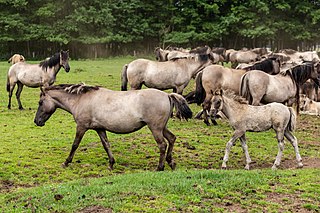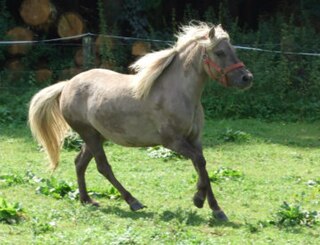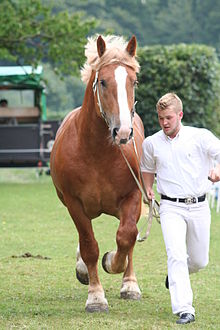
The Dülmener or Dülmen is a German breed of small feral horse. It was formerly known as the Merfelderbrücher. A herd of approximately 300 head lives in feral conditions in an area of about 3.5 km2 in the Merfelder Bruch, near the town of Dülmen in the Kreis of Coesfeld in north-western Nordrhein-Westfalen, in north-western Germany.

The German Pinscher or Deutscher Pinscher is a German breed of terrier in the Pinscher and Schnauzer group. It shares common origins with the Schnauzer, of which it is essentially a short-haired equivalent. It is seen in two colours, either black-and-tan or self-coloured red, this varying from deer-red to a dark reddish brown.

The Freiberger or Franches-Montagnes is a Swiss breed of horse of light draught type. It originates in the Canton of Jura in north-western Switzerland, and is named for the Freiberge or Franches-Montagnes District in the south of that canton. It is widely distributed in Switzerland, and is also present in France and Belgium.

The Hinterwald is an old local breed of cattle from the Black Forest (Germany). There are breed associations in Germany and one in Switzerland.

The Emden or Embden is a German breed of domestic goose. It is named for the town of Emden in north-westernmost Germany.

The Rhenish German Coldblood, German: Rheinisch Deutsches Kaltblut, is a breed of heavy draught horse from the Rhineland area of western Germany. It was bred in second part of the nineteenth century, principally at the Prussian state stud at Schloss Wickrath in Wickrathberg, now part of Mönchengladbach in North Rhine-Westphalia.

The Black Forest Horse is an endangered German breed of light draft horse from the Black Forest of southern Germany.

The Lakenvelder or Lakenfelder is a breed of domestic chicken from the Nordrhein-Westfalen area of Germany and neighbouring areas of the Netherlands. It was first recorded in 1727.

The Rottaler is a German breed of riding and carriage horse of heavy warmblood type. The name derives from that of the Rottal, the valley of the Rott in the Landkreis of Rottal-Inn in south-eastern Bavaria. It is critically endangered. The Bavarian Warmblood derives from it.
The Arenberg-Nordkirchen, German: 'Arenberg-Nordkirchner', is a breed of small riding horse from north-west Germany. It was believed extinct in 1985, but in 1995 a small number were discovered, and since 1999 the population has remained stable at about 20–25 head. The Arenberg-Nordkirchen is in the highest-risk category of the Rote Liste of the Gesellschaft zur Erhaltung alter und gefährdeter Haustierrassen, the German national association for the conservation of historic and endangered domestic animal breeds.

The Gesellschaft zur Erhaltung alter und gefährdeter Haustierrassen or GEH is a German national association for the conservation of historic and endangered domestic animal breeds.

The Rotes Höhenvieh is a breed of red cattle from the Central Uplands of Germany. It was created in 1985 as a merger of the few remaining examples of a number of closely similar regional breeds of upland red cattle. Reconstruction of the breed was made possible by the discovery of a stock of semen in a sperm bank. The name means "red upland cattle".

The South German Coldblood is a breed of draught horse from southern Germany. It is distributed mainly in Bavaria. It is the most numerous of the four principal German draught horse breeds – the others being the Black Forest Horse, the Rhenish German Coldblood and the Schleswig Coldblood – and is the only one not listed as endangered by the FAO or by the Gesellschaft zur Erhaltung alter und gefährdeter Haustierrassen, the German national association for the conservation of historic and endangered domestic animal breeds.
The Rote Liste, full name Rote Liste der bedrohten Nutztierrassen im Bundesgebiet, is a red list of threatened breeds of domestic animal published annually by the Gesellschaft zur Erhaltung alter und gefährdeter Haustierrassen, the German national association for the conservation of historic and endangered domestic animal breeds.

The Senner or Senne is a critically-endangered German breed of riding horse. It is believed to be the oldest saddle-horse breed in Germany, and is documented at least as far back as 1160. It is named for the Senne, a natural region of dunes and moorland in Nordrhein-Westfalen, in western Germany, and lived in feral herds there and in the Teutoburger Forest to the east.

The Augsburger is an endangered German breed of domestic chicken. It originates from the area of the city of Augsburg, in the Swabian region of the state of Bavaria, in southern Germany. It was bred in the nineteenth century, and derives mostly from the French La Flèche breed. It is the only chicken breed of Bavarian origin.

The German Pekin, German: Deutsche Pekingente, is a European breed of domestic duck. It is commonly called simply Pekin or White Pekin. It is a different breed from the American Pekin, which is also commonly known by the same names. It was bred in Europe from birds originating in China and Japan and is distributed in many European countries.

The German Classic Pony or German: Deutsches Classic-Pony is a modern German breed of riding pony. It derives from the traditional Shetland Pony of the Scottish Shetland Isles, but is principally influenced by the taller and more elegant American Shetland Pony.

The Niederrheiner is a German breed of chicken. It is named for the Niederrhein or Lower Rhine region where it originated in the early twentieth century, and derives principally from the Dutch North Holland Blue meat chicken. It was recognized in Germany in 1943. In the twenty-first century it is an endangered breed.


















